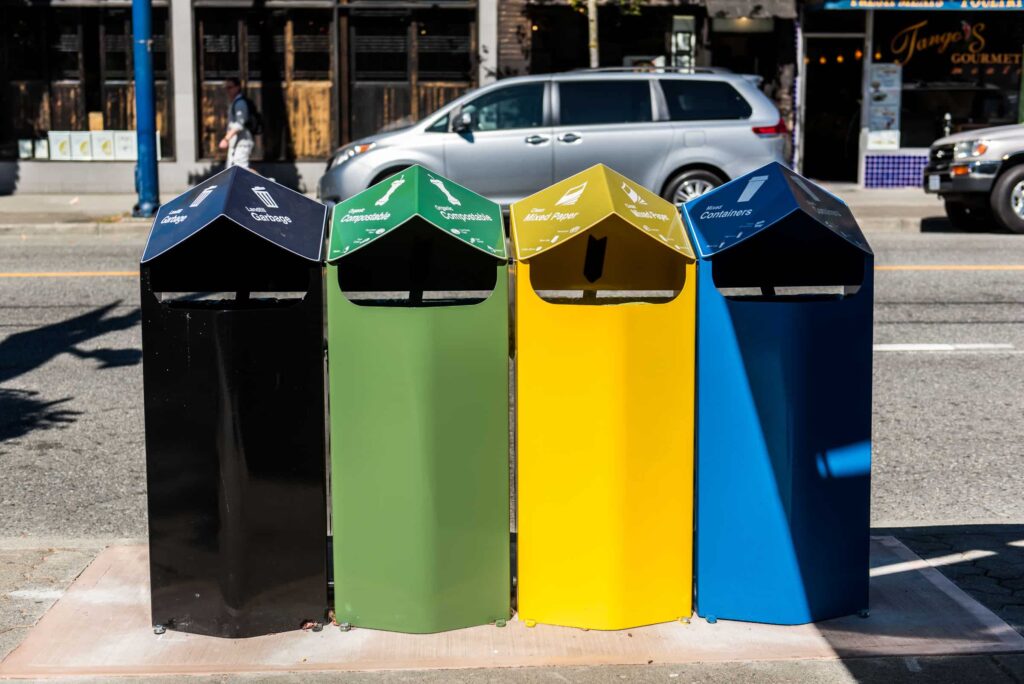Last week we covered the importance of sorting, and this week we will share some tips on how to sort materials for collection in the Recycle BC residential packaging and printed paper recycling program.
First, a little background on how recycling is collected: Depending on where you live, you might have to sort paper and cardboard into a different collection container from metal and plastic packaging and cartons and coffee cups. This kind of collection, referred to as multi-stream, uses a collection truck with multiple compartments for the sorted materials. When the truck arrives at a sorting facility, the truck unloads the paper and cardboard in one area and metal and plastic packaging and cartons and coffee cups in another area, ensuring that the materials don’t get mixed together. If non-deposit glass containers are collected, they are kept in a third compartment on the truck and unloaded in another area at the facility.
The different streams of materials are then processed, with the paper and cardboard baled for shipment to material remanufacturers and the metal and plastic packaging and cartons and coffee cups travelling through a series of conveyor belts and machines to be sorted into different packaging types before being baled and shipped.
Some communities collect paper and cardboard in the same collection container as metal and plastic packaging and cartons and coffee cups. The container is emptied into the collection truck, and the truck empties everything into the same place at the sorting facility. However, if non-deposit glass containers are collected, they are kept in a separate compartment on the truck and unloaded in another area at the sorting facility. This kind of recycling collection is called single-stream recycling. Since everything is mixed together, everything (but glass) passes through the sorting facility before it is baled for shipment to material remanufacturers.
Sorting tips:
1. Set out only packaging and printed paper in recycling containers.
Your local recycling collector will have specific instructions for how and when to set out your recycling, but if it is collected as part of the Recycle BC program, you can include any of the packaging and printed paper from our list of accepted items. If your collection is multi-stream, please sort as follows:
- Paper and Cardboard collection container (typically a reusable bag or a blue box): newsprint, flyers, office paper, letters and envelopes, boxes, paper bags, paper egg cartons, toilet paper or paper towel tubes, and shredded paper (contained in a paper bag or box), etc. Flatten large cardboard boxes that do not fit in the collection container and place beside the container.
- Cartons and Coffee Cup + Plastic and Metal Packaging collection container (typically a blue box): cartons and coffee cups; plastic jugs, jars, tubs, and trays (for milk, spreads, yogurt, fruit, etc.); caps, tops, lids, pumps; plastic clamshells for fruit or bakery items; plastic garden plant pots and seedling trays; plastic or aluminum takeout containers; empty aerosol cans; metal cans for food; spiral-wound cans for frozen juice, chips; etc.
- Glass collection container (typically a different coloured box if collected from curbside or multi-family building in a separate container): non-deposit glass bottles and jars for vinegar, edible oils, spreads, etc.
Other recyclable items, including ones that are accepted in the Recycle BC program but not at curbside or in multi-family collection, specifically plastic bags and overwrap and foam packaging, and non-deposit glass containers if they are not collected from the curb or multi-family buildings, need to be taken to a depot so they can be recycled. Recycle BC depots are listed here. Batteries, appliances, light bulbs, and many other household materials are also accepted for recycling at depots; check http://www.bcrecycles.ca/ for information about other recycling options and locations.
Please do not include garbage and food waste with your recycling, as these spoil the recyclability of materials and are unpleasant for workers to deal with
2. Include only empty packaging and containers.
Leaving food or cleaning supplies in your containers is wasteful, and can attract pests and or wildlife to your home and at sorting facilities. You can go a step further and rinse your containers, too. One way to do this is to give them a quick rinse or soak in your dish water after hand-washing dishes.
3. Ensure all aerosol containers are completely empty.
4. Keep recycling loose.
Recycling tied within plastic bags or stuffed into other containers cannot be sorted properly. To save space in your recycling container, flatten containers and cartons instead.
Following these tips will help ensure that the materials we collect are recycled properly.




